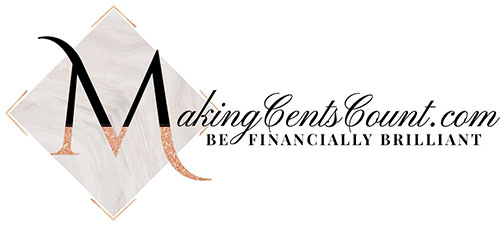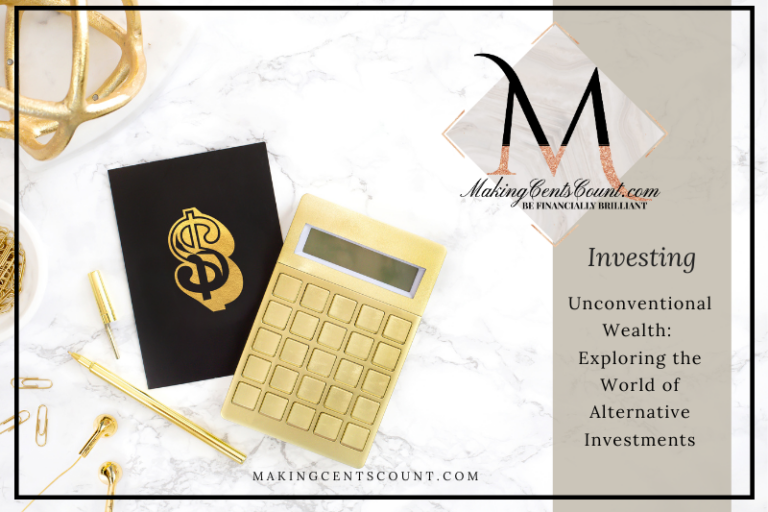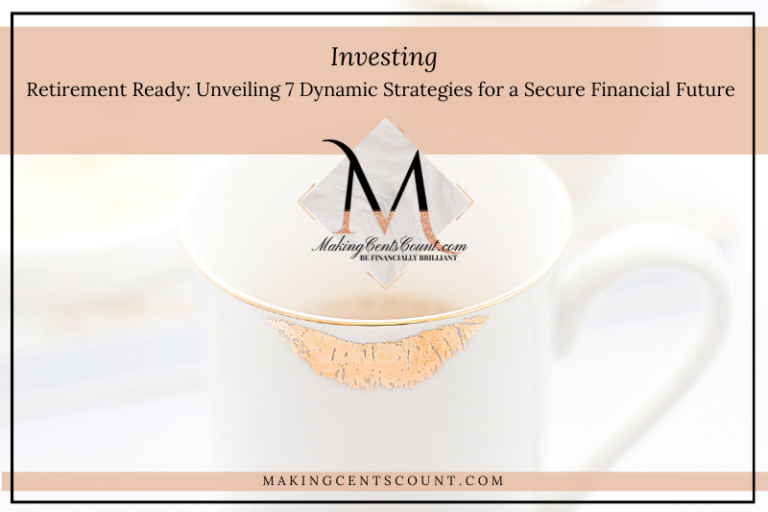The “Cash Drag” Impact on Investment Performance and Your Retirement Account
Estimated reading time: 10 minutes
What is cash drag and how does it impact investment performance and your retirement account? Cash drag refers to the additional cost associated with owning a mutual fund. Fund managers allocate a portion of assets to cash for liquidity purposes. However, this practice can hinder performance if stocks outperform cash holdings. Essentially, cash drag negatively impacts a fund’s performance due to uninvested cash. It can also affect individuals who choose to hold cash instead of investing in the market. In rising markets, cash tends to underperform, resulting in negative cash drag. Conversely, in falling markets, cash tends to outperform, leading to positive cash drag.
Are you ready to start investing, control your finances, and prepare for retirement? Join our amazing community! You’ll receive exclusive financial tips from Making Cents Count, as well as unlimited FREE access to our resource library full of money-saving tools and guides.
The Curse of Cash Drag: How it Undermines Returns
Cash drag can have a negative impact on your overall investment returns. While cash offers stability, it does not contribute significantly to generating returns. Consequently, the higher the cash holdings of a mutual fund, the lower its potential earnings and, consequently, your overall return.
In other words, when a portion of a portfolio allocates cash or cash-equivalent securities instead of securities that the portfolio primarily focuses on, the cash component lacks market exposure.
Unveiling the Cash Drag Dilemma: The Perils of Uninvested Funds
Cash drag, also known as uninvested cash, occurs when funds are deposited into an investment account but remain idle as a reserve for an extended period instead of being actively invested. This can result in an opportunity cost, as potential profits that could have been earned may be lost. By comprehending and effectively mitigating cash drag, investors can optimize their investment returns and minimize missed opportunities for growth. By actively managing their cash reserves and deploying them strategically, investors can ensure that their funds are continuously working for them, maximizing their potential for long-term financial success.
Unraveling the Impact of Fee Implications on Mutual Funds: The Cash Drag Conundrum
While mutual funds offer a convenient way to invest in a diversified portfolio, it is essential to understand the concept of cash drag and its potential impact on your overall returns. By considering fees, fund type variations, and retirement account implications, you can make informed decisions about your investments and mitigate the effects of cash drag.
The fees associated with mutual funds directly impact cash drag. Increased fees result in reduced investment capital, leading to a higher cash drag. Actively managed funds, which typically come with higher fees, particularly exhibit this effect.
The cash drag impact is a frequently disregarded expense that arises when a mutual fund or ETF holds a substantial amount of cash. This can diminish your investment returns since cash yields a lower return than the investments in the fund. Investors should strive to invest in securities that are fully allocated to the sectors/strategies they are intended for.
For instance, consider an investment of $10,000 in a mutual fund with a 10% cash position. The fund’s investments generate an average annual return of 10%. Nevertheless, due to the fund’s 10% cash holding, the actual return would be 9%.
In addition to potential cash drag effects, investors should consider various factors when choosing mutual funds. These factors encompass performance history, portfolio diversification, and management style. It is equally important to periodically review and update investments in accordance with risk tolerance and long-term financial goals.
Unleashing the Cash Drag: The Cost of Holding onto Cash in a High Inflation Environment
Another drawback of cash drag is the inability to hedge against inflation. Over time, inflation gradually diminishes the purchasing power of cash, meaning that the same amount of money will purchase fewer goods and services in the future. Assuming an annual inflation rate of 3%, the purchasing power of one dollar decreases by 3 cents each year. If your investment does not yield at least a 3% return, inflation will steadily erode your funds. Conversely, investing in productive assets, particularly those that perform well during inflationary periods, can help safeguard and even enhance purchasing power.
Uncovering the Cash Drag: Actively Managed Funds vs. Passively Managed Funds
Actively managed funds generally exhibit a higher cash drag compared to their passively managed counterparts. This is attributed to the active trading practices employed by fund managers, who maintain a cash buffer for potential investment opportunities.
For example, a portfolio with an average return of 10% and a 0.25% cash reserve will experience a performance impact of 0.025%. While this may appear insignificant, it can have notable implications for asset managers handling substantial amounts of capital, like $10 billion.
On the other hand, index funds, which are passively managed funds, tend to have lower cash drag because of their buy-and-hold strategy.
Passively managed funds do not aim to outperform a designated index. Instead, their objective is to closely replicate the index’s performance by holding similar securities in the same proportions. The fund managers only make necessary adjustments to align with the index.
To reduce the impact of cash drag on your investments, consider investing in low-fee index funds or exchange-traded funds (ETFs) that have a lower cash drag. Additionally, regularly reviewing and rebalancing your investment portfolio can help minimize potential cash drag effects.
Maximizing Returns: Unlocking the Power of ETF Cash Equitization
One of the frequently disregarded challenges encountered by contemporary investors is the presence of excessive and unnecessary cash in their portfolio. Exchange-traded funds (ETFs), with their numerous applications, provide a straightforward strategy for managing liquidity and ensuring that temporary cash is effectively utilized.
Let’s break it down. In the context of investing, “excess cash” refers to small amounts of money that gradually accumulate over time. This can occur due to asset turnover or unallocated deposits. As cash is not assigned to any specific asset, it remains idle, generating no returns.
To mitigate the impact of excess cash holdings on portfolio performance, investors can implement a cash equitization strategy. This strategy aims to enhance returns by reducing the drag caused by idle cash. By “equitizing” their portfolio, investors can actively monitor unintended cash levels and allocate those funds towards futures contracts or other derivatives products. This approach allows investors to align their investments with the underlying market and optimize their returns.
Unpacking the Damaging Effects of Cash Drag on Venture Capital Funds
To grasp the concept of cash drag, it is crucial to have a clear understanding of how a Venture Capital (VC) fund operates. A VC fund pools funds from various investors and utilizes them to invest in startup companies. When these startups thrive, the investors in the VC fund reap the rewards and receive a return on their investment. To secure the necessary funds for investment, the VC firm initiates a capital call, obligating the investors who have agreed to provide funds to make their investments. Once the investors have made their investment, they begin assessing the internal rate of return (IRR) on their investment. This evaluation serves as a significant criterion for assessing the success of the VC firm.
Cash drag refers to the uninvested cash held by a VC firm, resulting in little or no return. It is crucial to address this issue promptly as the Internal Rate of Return (IRR) is time-sensitive. When a capital call is made, the pressure mounts on the VC fund to invest the investors’ money in startups. Failure to do so hampers the average return on the funds, presenting a significant challenge. However, an even greater setback is missing out on a promising startup investment due to insufficient available capital.
The Venture Capital Balancing Act: Striking the Right Mix of Investment Dollars and Agility
Venture Capital funds face a constant juggling act, balancing the need for readily available investment dollars with the agility to seize good opportunities swiftly. Excessive cash can lead to cash drag, while insufficient funds can hinder investment capabilities. Striking the right balance is crucial for VC fund success, demanding meticulous planning and management.
To mitigate cash drag, venture capital firms must take a proactive approach in their investment strategy. It is imperative for them to possess a comprehensive understanding of the startup landscape and swiftly identify promising opportunities. This necessitates conducting extensive research and due diligence to ensure that the startups they invest in exhibit potential for high returns. Additionally, establishing robust relationships with startup founders and fellow investors is crucial, enabling them to promptly identify and access investment prospects.
Avoid the Cash Drag: Protect Your Retirement Account
When evaluating retirement accounts, it is crucial to be fully aware of the long-term implications of cash drag. Cash drag refers to the negative effect that even a small percentage of uninvested cash can have on the potential earnings of your retirement savings over time. This phenomenon can significantly impact the growth and overall performance of your retirement portfolio. Therefore, it is of utmost importance to carefully consider and take into account the potential cash drag when selecting mutual fund investments for your retirement accounts. By doing so, you can maximize the growth and optimize the performance of your retirement savings in the long run.
Revealing the Truth: Every Investment Has Risks and Costs, Cash Drag or Not
Although cash drag may initially appear as a drawback of mutual funds, it is crucial to bear in mind that every investment entails its own set of risks and costs. By comprehending the impact of cash drag and taking other factors into consideration when choosing a mutual fund, you can make well-informed decisions that align with your financial objectives. Regularly reviewing and adjusting your investments as necessary, and staying informed about fees and potential market changes, are paramount. With the right approach, mutual funds can serve as a valuable tool in constructing and maintaining a successful investment portfolio.
It is crucial to be proactive in exploring various investment options and strategies to optimize your financial growth. To make informed decisions, consider seeking guidance from a trusted financial advisor or conducting thorough research on your own. Understanding concepts like cash drag, which refers to the negative impact of uninvested cash on portfolio returns, is vital. By minimizing cash drag and maximizing investment potential, you can take significant strides towards accomplishing your financial goals. Stay informed, stay focused, and let your money work for you!
Secure Your Future: Burhoe Insurance Solutions for Retirement Protection
At Burhoe Insurance Solutions, we possess a deep understanding of insurance and retirement products. Rather than pushing proprietary products, we collaborate with over 30 insurance agencies to craft tailored Retirement Protection plans for our esteemed clients. We recognize that each individual has a unique financial situation and distinct goals, which is why we never adopt a one-size-fits-all approach. Our dedicated team takes the time to thoroughly comprehend your family’s needs, budget, and concerns to identify the ideal solution for you. With Burhoe Insurance Solutions, you can trust us to safeguard your life’s journey.
Mastering Your Money: Seizing Financial Control Today, Securing Tomorrow
If working on your finances is one of your goals right now (or, maybe it’s been a goal for some time), I suggest starting with the Making Cents Count Financial Organizer.
Our financial organizer is the robust answer you need. The organizer is our DIY financial services option, providing you with the tools to eliminate financial overwhelm.
In the exclusive Making Cents Count Financial Organizer, you’ll get:
- Clear strategies to get your finances under control
- Processes to organize and streamline your investments
- Guidance to track your legal documents, tax information, and permanent records
- Markers to know when you should meet with an attorney to establish a will or trust
- Templates, checklists, and step-by-step actions
- Insights on the financial-must haves to build a secure future
- Detailed How-To Guide for optimal results
If you want financial confidence, grab the Financial Organizer, and get results that fit *your* lifestyle!
Making Cents Count Financial Organizer
Once you get your budget rolling, check out my post on 6 Simple Steps to Get Financially Organized. This post also includes a helpful checklist available in my Resource Library (free to access).
Admittedly, this particular checklist has a larger-scale focus on your overall financial picture, but I genuinely feel that getting your finances organized is essential.
I’m so excited to invite you to join our Financial Success Society Waitlist! Our enrollment opens soon (so don’t miss a chance to get on the notification list). Your journey to financial success is unique and with this exclusive membership, you’ll receive the guidance you desire, enabling you to move financially forward, no matter where you are in your financial journey. At Making Cents Count, we offer an array of outstanding products and services to help you get control of your finances so they won’t control you!







